Do you also want something unique in your living room? Or are you considering making epoxy tables for customers? Then you are in the right place. In this article you can read and see everything you need to know and what you need to make a unique tree trunk table with epoxy.
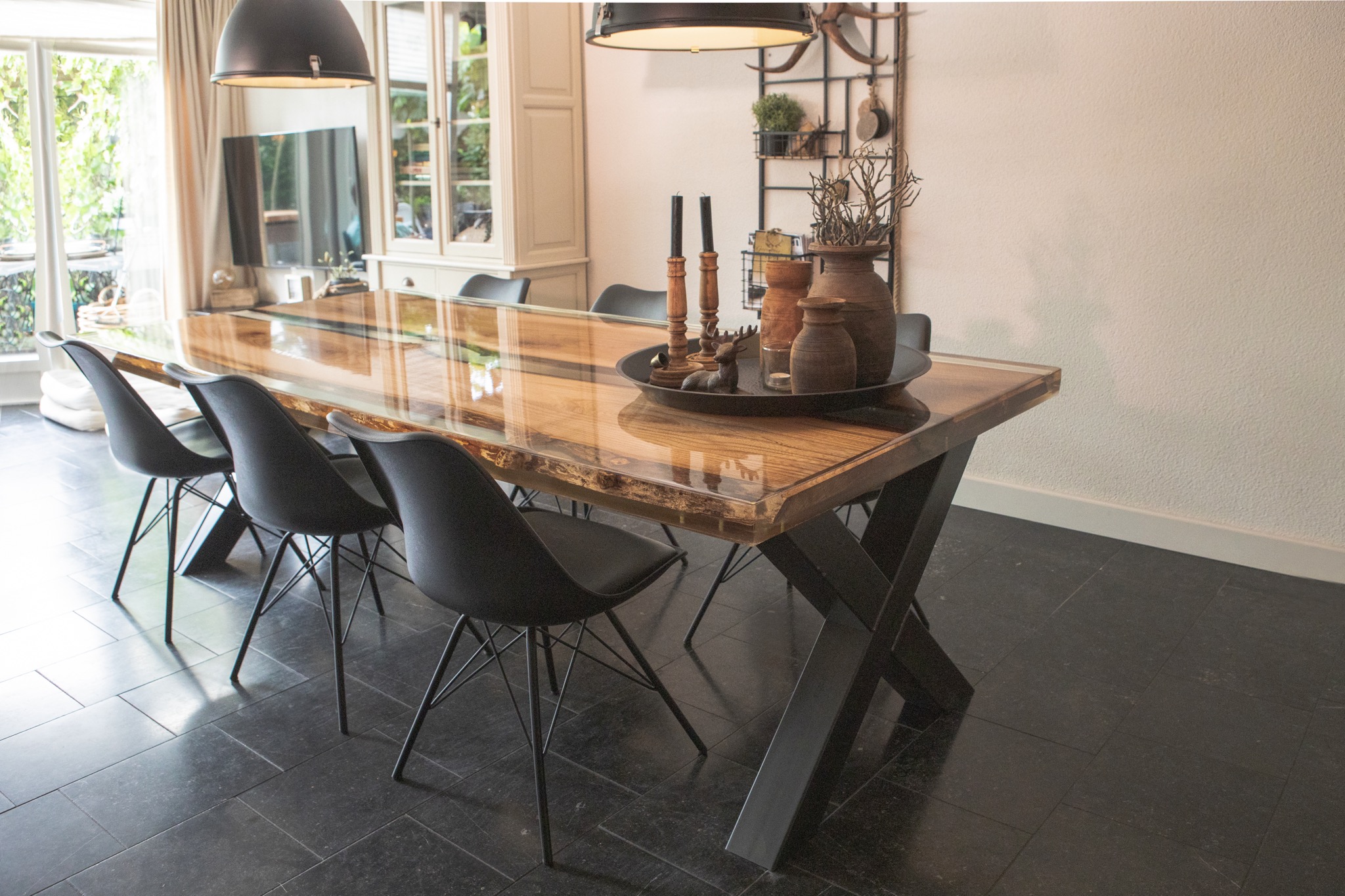
We have divided the making of an epoxy tree trunk table into 3 phases.
For each phase we explain what you need and what steps you need to take to achieve a great result.
Specifications Polyester shopping XL tree trunk table:
Length: 244 cm
Width: 110 cm
Amount of epoxy: approximately 100 kg
Wood: elm wood
Legs: steel cross legs
We have also recorded all the steps during the making of our epoxy tree trunk table in a great instructional video:
Supplies needed for priming wood with epoxy:
First, you choose the type of wood you want to work with. There are various specialist companies that sell tree trunk table tops. It doesn't matter what type of wood you choose, as long as it is well dried. Moisture in the wood can lead to improper curing of the epoxy and, because the wood "breathes", cracks can also appear in the epoxy. Therefore, try to ensure that your chosen piece is dried for a few months.
Once you have acquired the wood needed for your tree trunk board, it is important to cut it to the desired size. If you are going to make a table from two pieces of wood, you will get a better result by cutting both boards exactly the same way. We also had our boards made with fear. Of course, it is also important to pay attention when purchasing that the trunk boards are not too twisted.
Priming the wood is an important step to completely seal the wood. For this reason it is called "priming". You do not do this with any primer, but with Resion UV Epoxy. Prepare approximately 300 grams of epoxy casting resin per square metre. Impregnate the wooden boards well with the epoxy and use a brush for the most difficult areas. After application, purge the casting resin with a gas burner.
You need to repeat this process several times. It is best to cover each spot with the epoxy at least 2-3 times and let it dry for 24 hours each time. Are there any air bubbles in the epoxy after it cures? First sand with 80 grit and clean everything with acetone before applying a new coat of epoxy.
Priming is an important process. This avoids unexpected reactions when you start pouring later. Because the entire board is "sealed", air will no longer be able to escape from the wood when the thicker layer is poured.
To ensure that the top of the tree trunk table is properly arranged, you need to make a mould for the table. Use a melamine plate for this. Determine the size of the table and take into account the thickness of the walls that will be placed at the bottom. The length of the walls is not extremely important. This is not a problem for the formwork and saves you a lot of adjustments and measurements.
Cover all the wood with clear packing tape. Let it overlap slightly. Epoxy does not stick to packing tape, so you can easily remove the formwork around the epoxy later.
Seal all seams with silicone caulk. Epoxy also does not adhere to silicone caulk. Press well with your fingers to give it a nice finish.
It is also important to reinforce the bottom of the mould with thick beams. Screw them onto the bottom. Check the length of the screw carefully. Beams or the like ensure that the top will not sag when the epoxy is further curing. Place the mould on a number of sturdy sawhorses. Also make sure your table top is all one level because otherwise the boards will be tilted in the epoxy later!
Supplies needed for pouring epoxy:
The best thing is to have the wood approximately in the middle. This means you will also see a layer of epoxy at the bottom. The trunk boards will also be completely closed and the table extremely sturdy. For a thickness less than 1 cm, approximately 11 kg per square metre is required. If you want to do it all at once, you can create 11 kg with RESION 2K volume (for large castings).
Preheat the epoxy resin base to 30 degrees or use a vacuum boiler. Mix the epoxy in an empty bucket with a butterfly mixer on the drill. Work at a slow speed and scrape the bottom and sides of the bucket well. First, pour a small amount of epoxy into your muold to prevent any leaks. Next, pour the remaining epoxy into the mould. With a spreader you can distribute the resin quickly and evenly.
Now that the boards have been primed with epoxy, they can be positioned in the mould and a thin “glue layer” can be poured. It is not advisable to pour too much immediately. You run the risk of the boards "floating" and therefore not hardening in the right place. Make approximately 4 kg to 5 kg (per square metre) of Resion UV epoxy and pour it into the mould after laying the boards. After pouring, purge with a gas burner.
Once the boards are glued, we fill the entire mould with epoxy to get a nice thick layer. It is best to do this within 24 hours after pouring the adhesive layer. This way you will always have sufficient chemical adhesion.
In principle, Resion 2K Volume (epoxy casting resin for large castings) can process up to 10 cm in one go. However, it is not advisable to do so. We recommend pouring a maximum of 20 kg of epoxy per square metre at one time.
Prepare the epoxy in a large 20 litre bucket. There are two things you can do to prevent air bubbles as much as possible. Preheat the resin to around 30 degrees. Hotter epoxy resin is much thinner and air escapes more easily. With Resion 2K Volume this is not a problem due to its extremely long lifespan. Secondly, you can prevent air bubbles by mixing the epoxy at a slow speed with a butterfly mixer on a cordless drill. Wear safety glasses and a coverall. Mix for about 2-3 minutes and also scrape the bottom and edges of the bucket.
Mix the epoxy with a butterfly mixer on a cordless drill. Do this at a slow speed to avoid air bubbles. Also wear safety glasses and clothing that fully covers your body. Mix for 2-3 minutes and scrape along the bottom and sides of the bucket. After mixing, carefully pour the epoxy into the mould. Then do the operation again and pour into the mould again. After pouring about 5 cm, you have about 2-3 hours to remove air bubbles using a gas burner.
Let it harden for about 24 hours. The epoxy will certainly not yet be hard, but it will be enough for a layer of 8 cm thick. The epoxy will then be sufficiently cooled and will still exhibit excellent chemical adhesion.
The final phase will determine how beautiful the epoxy tree trunk table will be. That's why you should definitely take the time for this.
Supplies for finishing the epoxy table:
Before we remove the tree trunk table top from the formwork, it is wise to let the epoxy harden properly first. Please allow 4 to 5 days for this. The longer you wait, the harder the epoxy becomes. First we will remove the formwork from the top. Then we can finish both sides. Removing the formwork can be a big job. The bottom in particular can be firmly attached because it is vacuumed against the epoxy.
Once all the walls have been removed, we can start with the bottom. Make a soft base of cardboard on the ground and place the entire leaf on it. Make a number of wedges from a soft wood. Try to gently tap the wedges between the bottom of the formwork and the epoxy.
A soft type of wood will not damage the epoxy too much. When the formwork has been completely removed, you can place the top back on the trestles. Make sure the top is on top. Please note: support the top well, otherwise you run the risk of it sagging in the middle. This also prevents the trestles from pressing into the epoxy. You can use the bottom of the mould as support if necessary.
To create a nice edge, it is best to use a router sander. This way you get consistent rounding. This is also possible with a sander and 40 grit sandpaper, but this gives less precise results. Then sand the top completely with 80 grit and clean it with acetone. We're going to pour a final coat of Resion UV epoxy onto our table top. This will make the curves look even better and ensure the surface is completely flat.
Prepare approximately 1 kg of epoxy per square metre. Make sure there is a protective film on the floor, as the epoxy will leak from the table top. If necessary, tape the bottom with tape. Mix the epoxy well and pour it onto the tray. With an epoxy spreader, you can distribute the epoxy evenly so that there is the same amount of epoxy everywhere. Finally, purge everything with a gas burner.
Allow the epoxy to cure for a minimum of 48 hours.
Once the board has been properly poured and the epoxy has cured, you can begin sanding and painting. Sand the entire top with 120 grit and go slowly towards 240 grit. Then clean the surface thoroughly with acetone.
Topcoat and polishing gives the epoxy dining table increased scratch resistance. Epoxy is hard but quite susceptible to scratches. If after a while the top becomes less attractive, you can easily polish it again with DD Paint.
Apply approximately 200 grams of DD Paint per square metre. The mixing ratio by weight is 2 parts base and 1 part hardener. Mix the two components well with a spatula and allow the DD Paint to react for approximately 20 to 30 minutes. Then add 3 to 4% brush thinner and mix again.
Wipe the table top with a tack cloth to remove any dust on it. Try to paint in a room that is as dust-free as possible. Apply DD polish with a foam roller. Work in lengths and repeat 1x.
Allow the polish to dry for 24 to 48 hours after application and sand the top again with 320 grit. Repeat the polish 3 to 4 times. If you apply 4 coats there will be enough room to polish it.
Allow the final coat of DD Paint to cure for at least 4 days before proceeding to the next step.
Before we finish the top, we finish the bottom first. You can also coat and polish the underside, but as the bottom does not need to be scratch resistant in most cases, polishing the epoxy with RESION High Gloss Polish is sufficient.
When the bottom is well out of the mould, you can start sanding from 320 grit. If there are any irregularities, they are a little coarser. Sand in stages up to 3000 grit. Be sure to clean your surface thoroughly before changing grits. Indeed, you could otherwise create abrasive scratches with the previous grain.
Sand from 1000 grit with water. Occasionally spray the surface with a sprayer. When you have sanded to 3000 grit, you can start polishing with Rupes UHS polishing paste.
Start with the sheepskin. Polish at low speed. Moisten the surface regularly with water to prevent it from becoming too hot. When the entire bottom is finished, clean it with a polishing pad and then a hard polishing pad. Then polish again with Rupes UHS polishing paste.
Now mount the legs under the table. Choose legs that can support the weight of the table and be careful when flexing the table top. When in doubt, install a third leg in the middle or weld a crossmember for added strength.
Draw the holes in the right place by placing the legs on the table. Then remove the legs and pre-drill the holes. This is important because otherwise the epoxy could crack. When the holes are pre-drilled, place the legs under the table top and screw them in with threaded bolts. When the legs are secure, turn the table over.
We are now at the last step: Finishing the table. Make sure you pay enough attention to this.
Sand from 320 grit to 3000 grit. Sand 1000 grit with water. Clean the surface every time you change grits. Once the table top is cleaned, you can polish it with Riwax RS02 and a sheepskin. Moisten the surface regularly with water to keep it at the right temperature. Then polish with Riwax RS06 and a black polishing pad. Do not polish at too high a speed. If the table top has been polished, you can clean it again with Riwax Surface Cleaner and a polishing cloth. Your epoxy dining table is now ready to use!
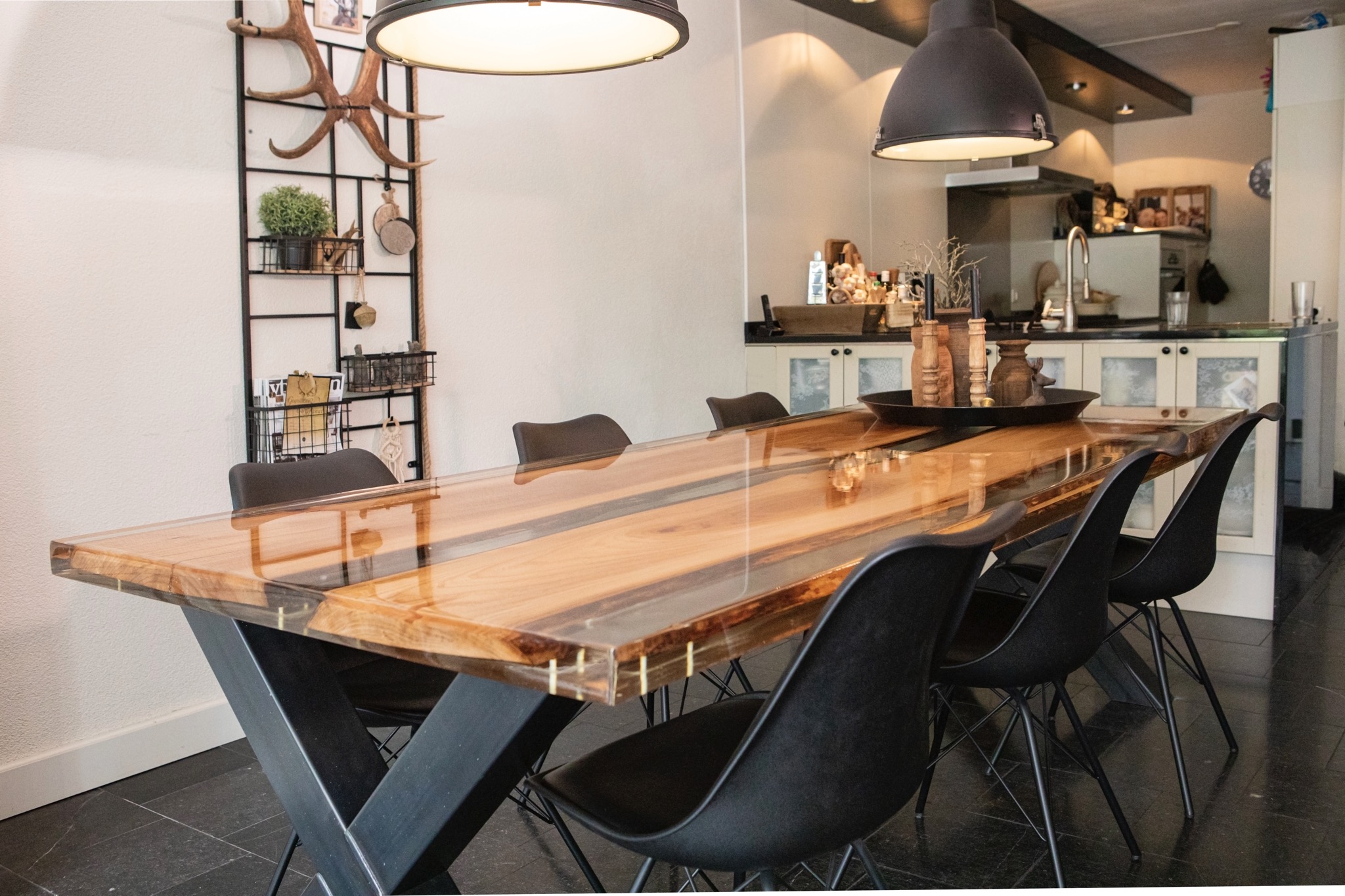
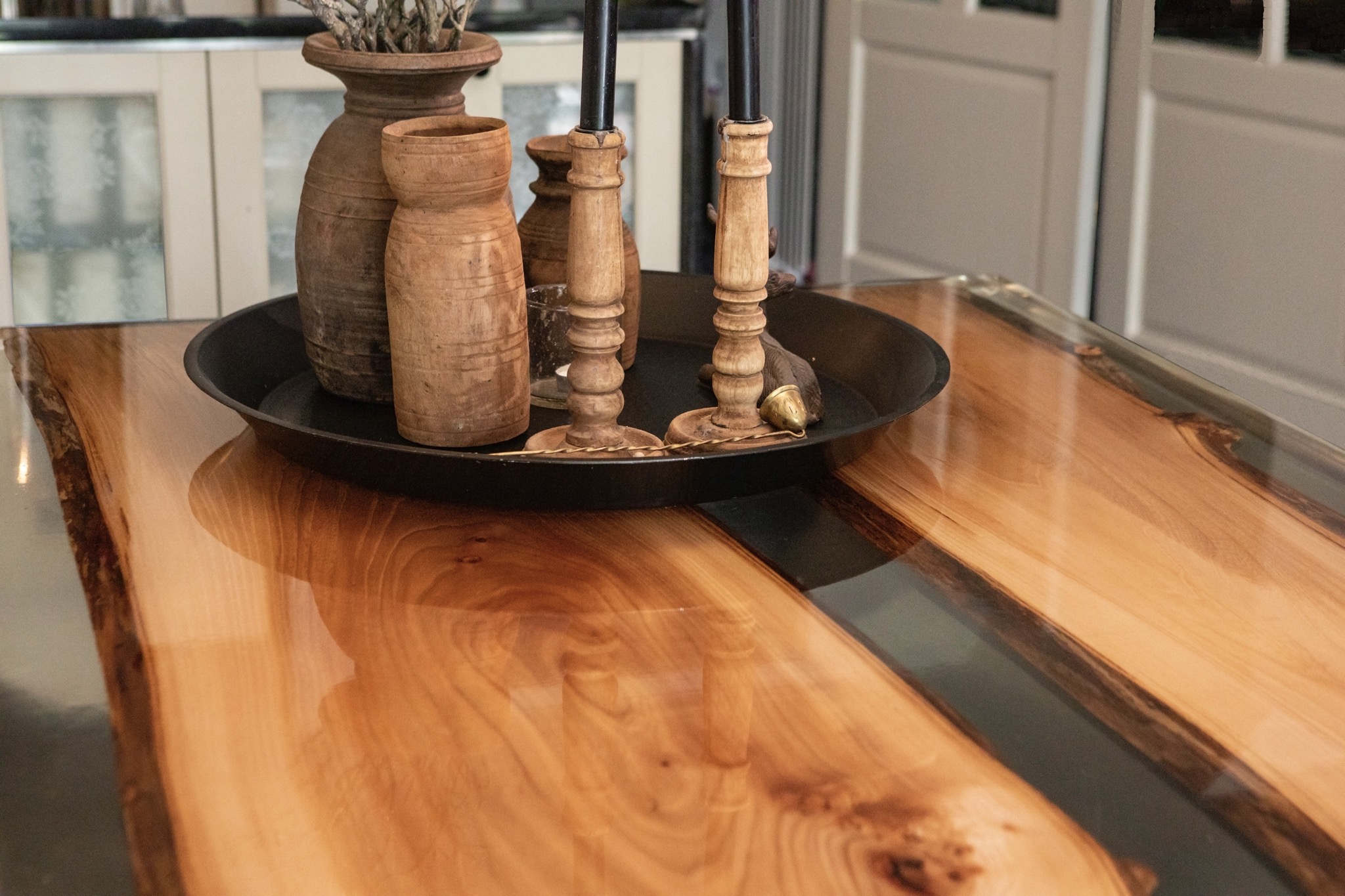
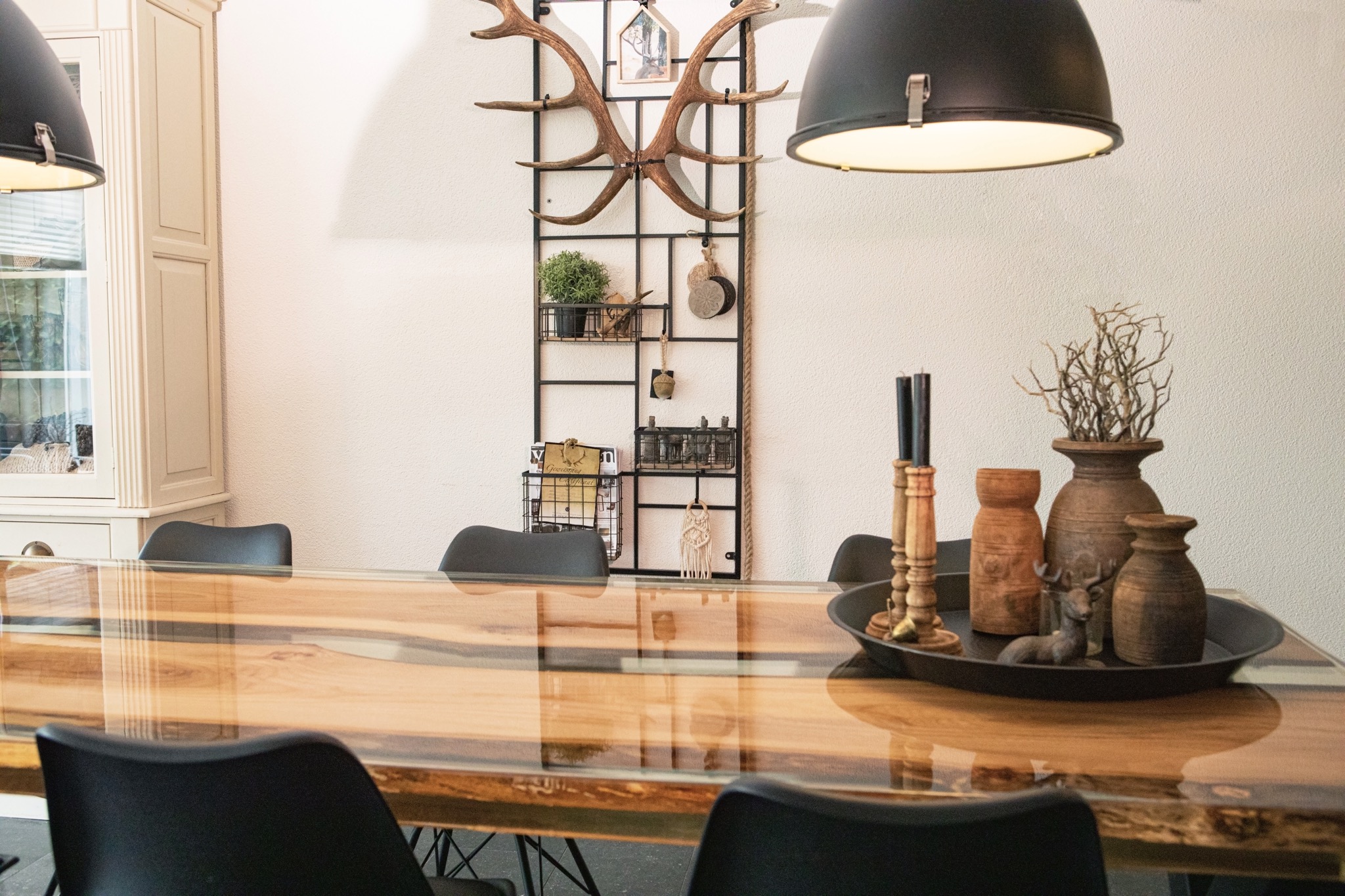
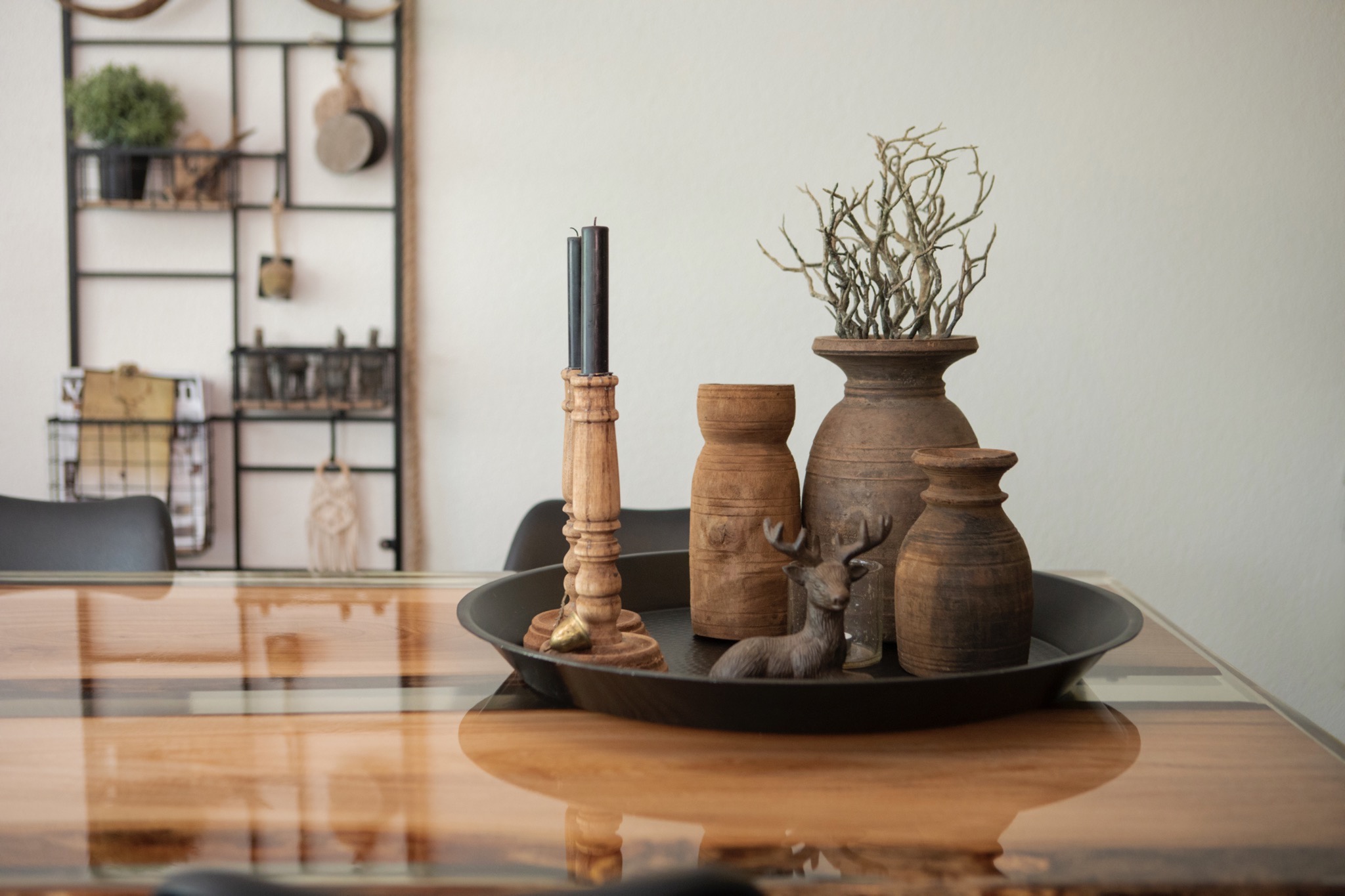
Here you can find all 9 related articles on this topic. Mis je informatie om aan de slag te gaan met jouw klus? Neem dan contact met ons op.
Do you have a specific question? Call one of our specialists for free advice +3185 0220090
